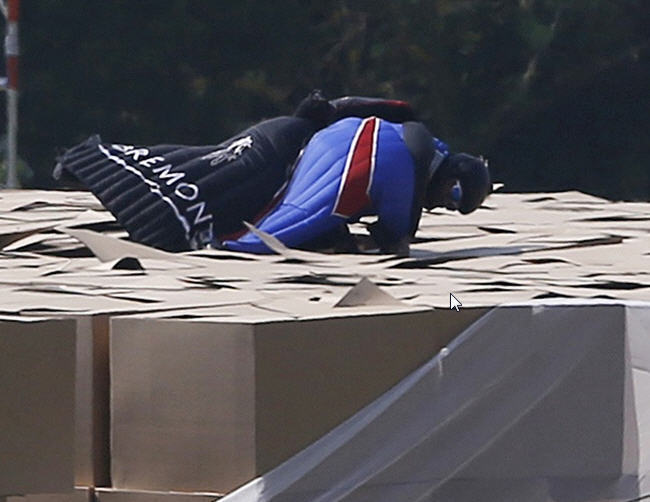Recommended Posts
Dave1216 0
QuoteIn the UK AADs are mandatory on all student rigs with the exception of S/L
I believe that piggyback static line require AAD's but 'traditional' (belly-mount reserve) don't.
I may be wrong, i invariably am!
gerrcoin 0
QuoteI believe that piggyback static line require AAD's but 'traditional' (belly-mount reserve) don't.
Not so. I've seen some back-mounted reserve S/Ls with no AAD and my rigger told me that it's not manditory here. In the US it is however. That is not to say that individual DZs don't have a rule on this for their own gear.
Note from original post
Quoteexcluding parachutists jumping Traditional (front & back) static line equipment
Dave1216 0
riggerrob 613
QuoteQuoteI believe that piggyback static line require AAD's but 'traditional' (belly-mount reserve) don't.
Not so. I've seen some back-mounted reserve S/Ls with no AAD and my rigger told me that it's not mandatory here.
Note from original postQuoteexcluding parachutists jumping Traditional (front & back) static line equipment
>>>>>>>>>>>>>>>>>>>>>>>>>>>>>>>>>>>>
That baffles me!
But then many British practices baffle me!
For example why are they still using fore and aft gear when the rest of the civilized world converted to piggy backs two decades ago?
AADs were fashionable on front-mounted reserves when I started jumping in Canada in 1977.
CSPA made AADs mandatory for everyone below A Certificate 20-some-odd years ago.
I have always believed that first-timers were the highest risk.
riggerrob 613
QuoteIn the US last year no/low pulls accounted for only 4% of the fatalities and they're not mandated here, people just tend to use them on their own. Is it really any different in the UK?
Edit: oh, and comparison to other causes of death, landings were 44%.
>>>>>>>>>>>>>>>>>>>>>>>>>>>>>>>>>>>>
Remember that before AADs became fashionable for experienced jumpers, low pull/no pull consistently represented 30% of fatalities in the USA. That was back in the 1960s, 1970s and 1980s.
This whole concept of requiring AADs below a certain license level is just administrators catching up with fashion.
90% of the reserves I repack these days contain AADs.
As for the A license jumper with 5,000 jumps .... tell him to hurry up and write the next exam!
jakee 1,379
QuoteBut then many British practices baffle me!
For example why are they still using fore and aft gear when the rest of the civilized world converted to piggy backs two decades ago?
Which DZ is that?
riddler 0
QuoteIn the US last year no/low pulls accounted for only 4% of the fatalities and they're not mandated here, people just tend to use them on their own.
USPA cites the reason as the drop from a ten-year average of 17% to the 4% last year as primarily due to the use of AADs and RSLs. AADs are required for students.
meatbomb 0
QuoteWhich DZ is that?
Skydive Strathallan for one!
We do about 1200 first timers a year, about 400 of which are rounds on front and back kit.
Rounds Rock!
Swoopert, CS-Aiiiiiii!
Piccies
QuoteNot so. I've seen some back-mounted reserve S/Ls with no AAD and my rigger told me that it's not manditory here. In the US it is however. That is not to say that individual DZs don't have a rule on this for their own gear.
This sounds a bit strange. The BPA opps manual states that student piggyback equipment must have an AAD and an RSL.
Quote
2.2 Piggyback
2.2.1. The following Wing Loading criteria should be applied to main ram-air canopies:
a. Ab-initio Solo Student Parachutists - not to exceed 0.8 lbs/sq.ft.
b. Solo Student Parachutists not including Ab-initio. - not to exceed 0.85 lbs/sq.ft.
SEC 6/PAGE 1/AUG 2001
N.B. The following exceptions to apply to the above:
Where the Canopy’s Manufacturer has published advice that a higher wing loading is suitable (when the manufacturer’s higher limit will apply).
or
Where the person has logged previous relevant parachuting experience.
or
Where the Student Parachutist is above average fitness, his/her CCI believes a higher wing loading is appropriate for him/her and the CCI has recorded clearance for a higher specified wing loading on the Record of Training.
2.2.2. The static line must be continuous from the deployment bag to the point of attachment in the aircraft.
2.2.3. The equipment must be fitted with an automatic activation device (AAD) and a reserve static line (RSL).




Not really. Our incidents are mainly due to low turns. In the UK AADs are mandatory on all student rigs with the exception of S/L (and maybe IAD - I'm not sure), but most DZs have a standing policy on their use for low license (A and B with low jumps). The unwritten rule was that if you were experienced enough to do CReW or birdman jumps then your safety was your own responsibility, but in that case you were probably already above B license anyway so it really makes no immediate difference. I think that the policy was aimed at enforcing the use of AADs at roaming DZs, which are beginning to increase in number. The only problem is telling a very experienced jumper who only has the A. Personally I don't any major issue with it but I'm just wondering if the USPA aren't watching how this works out.
There is also a Low Turns Committee talking about a way to reduce injuries from these. I believe that low turns cause the majority of actual injuries. Overloading may be a cause or contributing factor of some injuries but it's a hard thing to pin down. As yet they have no definite proposals regarding this.
Share this post
Link to post
Share on other sites